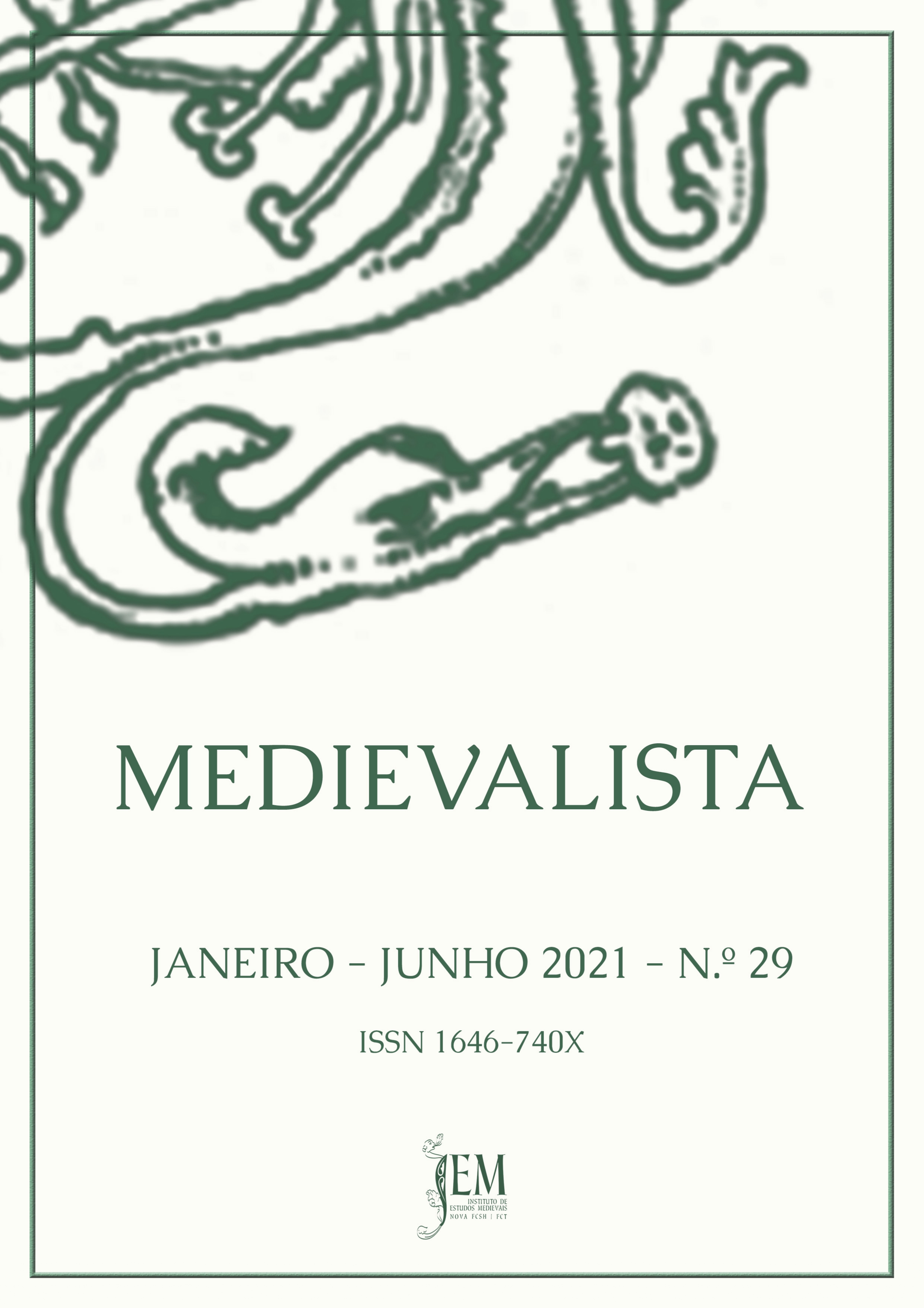The hundred eyes of the Peacock: Representations of the bird in the Middle Ages and its symbolic origins
DOI:
https://doi.org/10.4000/medievalista.3908Keywords:
Bestiary, Symbolism, Peacock, Middle Ages, ImaginaryAbstract
The peacock is considered one of the most beautiful animals in nature. This beauty, concerning the imaginary, becomes a key element in the narratives and arts that associate the peacock with the Hindu and Buddhist deities, but also with the pride and the vanity. This article tries to show how the symbolism of the peacock was transmitted and adapted from Ancient India to Medieval Europe, where the bird figured in the Christian creativity as an emblem of the immortality of Christ and the preachers of the Church, along with hagiographical narratives and biblical images.
Bibliography
Handwritten sources
Aberdeen, University, Bestiário de Aberdeen, Ms. 24. Disponível em https://www.abdn.ac.uk/bestiary/.
Library, Medicaen-Laurentian Library, Syriac Orthodox Resources – Miniatures from the Rabbula Gospels. Ms. Plut. I, 56. Disponível em http://sor.cua.edu/Bible/RabbulaMs.html.
Printed sources
ARISTÓTELES – History of Animals [Em linha]. Ed. Richard Cresswell, Project Gutenberg. (Consultado a 7 julho 2019). Disponível em http://www.gutenberg.org/files/59058/59058-h/59058-h.htm.
BARBER, Richard (Ed.) – Bestiary. Being an English Version of the Bodleian Library, Oxford, MS Bodley 764. Woodbridge: Boydell, 1999.
Bíblia de Jerusalém. São Paulo: Ed. Paulus, 2002.
CLARK, Willene B. (ed.) – The Medieval Book of Birds: Hugh of Fouilloy’s Aviarium. (Medieval & Renaissance Texts and Studies, 80). Binghamton, New York: State University of New York, 1992.
ELIANO, Cláudio – On The Nature Of Animals [Em linha]. Ed. A. F. Scholfield, 1958. (Consultado a 7 julho 2019). Disponível em http://www.attalus.org/translate/animals5.html.
ESOPO – Fábulas. Ed. Antônio Carlos Vianna. Porto Alegre: L&PM Editores, 1997.
ISIDORO DE SEVILHA – Etimologias. Ed. Stephen A. Barney; W. J. Lewis; J. A. Beach; Oliver Berghof – The Etymologies of Isidore of Seville. Cambridge: Cambridge University Press, 2006.
JACOPO DE VAZARRE – Legenda Áurea. Ed. Hilário Franco Júnior. São Paulo: Companhia das Letras, 2011.
MARCO POLO – The Travels of Marco Polo [Em linha], vol. 2. Ed. Henry Yule; Henri Cordier, Cap. XVIII. (Consultado a 7 julho 2019). Disponível em http://www.gutenberg.org/cache/epub/12410/pg12410-images.html.
PLINY THE ELDER – The Natural History [Em linha]. Ed. John Bostock, 1885. (Consultado a 7 julho 2019). Disponível em: http://www.perseus.tufts.edu/hopper/text?doc=Perseus%3Atext%3A1999.02.0137%3Abook%3D8%3Achapter%3D50.
SANTO AGOSTINHO – A Cidade de Deus. Parte II. São Paulo: Vozes de Bolso, 2014.
SANTO ANTÓNIO – Sermão do Primeiro Domingo da Quaresma. Ed. Henrique Pinto Rema – Santo António: Obras Completas. Porto: Lello & Irmão, 1987.
RAZI, Sharif (Trad.)– Nahjul Balagha: Peak of Eloquence. [Em linha]. DuasPublishing Project (Consultado a 7 julho 2019). Disponível em https://www.al-islam.org/nahjul-balagha-part-1-sermons/sermon-165-allah-has-provided-wonderful-creations#about-peacock.
Studies
ALLISON, Christine – “YAZIDIS i. GENERAL”. in Encyclopædia Iranica [Em linha]. (Consultado a 7 julho 2019). Disponível em http://www.iranicaonline.org/articles/yazidis-i-general-1.
ANĐELKOVIĆ, Jelena; ROGIĆ, Dragana; NIKOLIĆ, Emilija – “Peacock as a sign in the late antique and early christian art”. Archeology and Science 6 (2010), pp. 231- 268.
BEER, Robert – The Handbook of Tibetan Buddhist Symbols. London, Chicago: Serindia, 2003.
BERNARD, Meehan – The Book of Kells: An Illustrated Introduction to the Manuscript in Trinity College Dublin. New York: Thames and Hudson, 1994.
CAVALLINI, Andrea – La penna del pavone: Bibbia ed esegesi in Gioivanni Scoito Eriugena. Roma: Città Nuova, 2016.
CHEVALIER, Jean; GHEERBRANDT, Alain – Dictionary of Symbols. Paris: Penguin Reference, 1982.
CHEVALLIER, Jim (Ed.) – How To Cook A Peacock: Le Viandier: Medieval Recipes From The French Court. California: Chez Jim, 2008.
CHOSKYI, Jampa – “Symbolism of Animals in Buddhism”. Revista Buddhist Himalaya [Em linha] 1/1 (1988). (Consultado a 7 julho 2019). Disponível em: http://ccbs.ntu.edu.tw/FULLTEXT/JR-BH/bh117490.htm.
COOPER, Jean C. – An Illustrated Encyclopaedia of Tradicional Symbols. London: Thames & Hudson, 1978.
COTTERELL, Arthur – A Dictionary of World Mythology. New York: Perigee Book, 1979.
DALAL, Roshen – Hinduism: An alphabetic guide. New Dhéli: Penguin, 2011.
DE JONG, Albert – “The Peacock and the Evil One”. in ALLISON, Christine; JOISTEN-PRUSCHKE, Anke; WENDTLAND, Antje – From Daena to Din: Religion, Kultur und Sprache in der iranischen Welt. Wiesbaden: Harrassowitz Verlag, 2009, pp. 303-320.
DE LONGUYON, Jacques – Una redazione latina inedita dei voti del Pavone. A cura do Vincenzo Licitra. Spoleto: Centro italiani di studi sull'alto Medioevo, 1961.
DIXON-KENNEDY, Mike – Encyclopedia of Grego-Roman Mythology. Santa Bárbara: ABC-CLIO, 1998.
EDMONDS, John Maxwell (Ed.) – The Fragments of Attic Comedy. Vol. II. Leiden: E. J. Brill, 1959.
FRIEDMAN, John B. – “Peacocks and Preachers: Analytic Technique in Marcus of Orvieto’s Liber de moralitatibus, Vatican lot. MS S93S”. in CLARK, Willene B.; McMUNN, Meradith T. – Beasts and birds of the Middle Ages. Philadelphia: University of Pennsylvania Press, 1989, pp. 179-196.
FURLANI, Giuseppe – Gli adoratori del pavone: I Yezidi: i testi sacri di una religione perseguitata. Milano: Joovence, 2016.
JACKSON, Christine E. – Peacock. London: Reaktion Books, 2016.
KANG, Kyu-suk – “The Peacock”. Journal of Symbols & Sandplay Therapy 4/1 (2013), pp. 35-43.
LEO, Dominic – Images, Texts, and Marginalia in a "Vows of the Peacock" Manuscript. New York: Brill, 2013.
LOTHER, Helmut – Der Pfau in der altchristlichen Kunst. Leipzig: Dieterich, 1929.
LUDVIK, Catherine – Sarasvati, Riverine Goddess of Knowledge: From the manuscript-carrying Vina-player to the Weapon-wielding Defender of the Dharma. Leiden, Boston: Brill's Indological Library, 2007.
REIMBOLD, Ersnt Thomas – Der Pfau: Mythologie und Symbolik. Muenchen: Callwey, 1983.
RODRIGUES, Alessandro Pereira – Apício, De Re Coquinaria I-III: Introdução, tradução e notas. Rio Grande do Sul: Universidade Federal, 2010. Trabalho de Conclusão de Curso. (Consultado a 7 julho 2019). Disponível em https://lume.ufrgs.br/handle/10183/29146.
SYME, Alison – “Taboos and the Holy in Bodley 764”. in HASSIG, Debra (ed.) – The Mark of the Beast: Bestiary in Life, Art and Literature. New York, London: Routledge, 200, pp. 163-184.
TESTINI, Pasquale – “Il simbolismo degli animali nell’arte figurativa paleocristiana”. in L’uomo di fronte al mondo animale nell’Alto Medioevo. Atti (dal 7 al 13 aprile 1983). Vol. 2. Spoleto: Centro Italiani di Studi Sull'Alto Medioevo, 1987, pp. 1107-1179.
THANKAPPAN, P. Nair – “The Peacock Cult in Asia”. Asian Folklore Studies 33/2 (1974), pp. 93-170.
TRIFUNOVIC, Dorde – Fiziolog: slovo o hodecim i letecim stvorenjima. Pozarevac: Branicevo, 1973.
VARGAS, Ivette – “Snake-Kings, Boars’ Heads, Deer Parks, Monkey Talk: Animals as Transmitters and Transformers in Indian and Tibetan Buddhist Narratives”. in WALDAU, Paul; PATTON, Kimberly (Eds.) – A Communion of Subjects: Animals in Religion, Science, & Ethics. New York: Columbia University Press, 2006, pp. 218-238.
WERNESS, Hope B – Continuum Encyclopedia of Animal Symbolism in World Art. New York, London: Continuum, 2006.
WITZEL, Michael – “Substrate Languages in Old Indo-Aryan”. Electronic Journal of Vedic Studies [Em linha] 5/1 (1999), pp. 1-67. (Consultado a 7 julho 2019). Disponível in https://doi.org/10.11588/ejvs.1999.1.828.
Downloads
Published
How to Cite
Issue
Section
License
Copyright (c) 2024 Medievalista

This work is licensed under a Creative Commons Attribution 4.0 International License.





